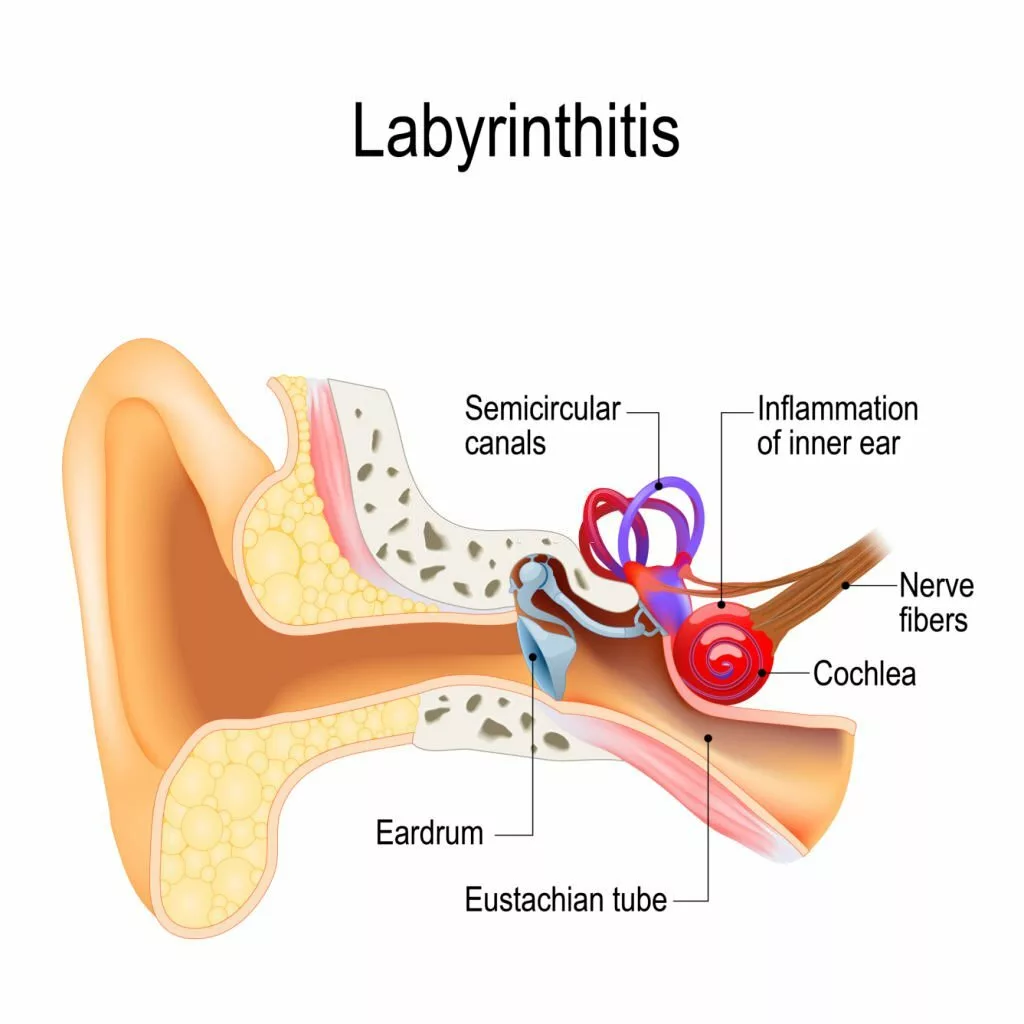Labyrinthitis is the inflammation of the labyrinth, which is the structure of the inner ear. This part of the ear contains the vestibular nerves that send signals to the brain about balance and spatial orientation. The infection may alter the ear’s signals to the brain, altering hearing and balance. It typically presents with vertigo, nausea, vomiting, tinnitus, or rarely hearing loss.1Wipperman J. Dizziness and vertigo. Prim Care. 2014 Mar;41(1):115-31. The condition usually appears overnight and goes away in a few weeks with treatment.
There is minimal epidemiological information, but the incidence seems to rise with age. Before diagnosing labyrinthitis, it is necessary to conduct a complete history, examination, and investigation because many other dangerous illnesses, such as a cerebrovascular accident (CVA), can mirror the symptoms of this disease. A bacterial or viral infection typically brings it on, although it can also be an effect of HIV or a systemic autoimmune condition.2Barkwill, D., & Arora, R. (2020). Labyrinthitis.

Causes of Labyrinthitis
Labyrinthitis is often caused by viral or bacterial infections, including common respiratory viruses such as the common cold and the flu. In some cases, it can result from bacterial infections like middle ear infections or, in severe cases, meningitis. An infection from the herpes family of viruses, which causes chickenpox, shingles, or cold sores, is the most frequent cause of labyrinthitis. These viruses cause the common cold, the flu, measles, glandular fever, and the flu.3Acar, M., Cingi, C., & Magnan, J. (2022). Labyrinthitis. Pediatric ENT Infections, 407-416. Several autoimmune disorders, allergies, and medicines can bring on Labyrinthitis. The most frequent causes are:
- Bronchitis or other respiratory conditions
- Viruses that cause inner ear infections
- Epstein-Barr virus and other herpes viruses
- Intestinal viruses
- Bacterial infections
Bacterial middle ear infections are very common in children. They can occasionally result from an infection in the middle ear that has migrated to the inner ear. Persistent (chronic) and untreated middle ear infections provide a greater risk in this regard. Bacterial meningitis, a head injury, or both can occasionally bring on the disease. Other times, the root cause is unknown.
Symptoms of Labyrinthitis
The symptoms appear fast and may be severe for several days. After that, they normally start to fade, but if you rapidly shift your head, they can return. Normal discomfort from the disease is minimal. A patient could have mild to severe symptoms. The symptoms include any of the following:
- Dizziness
- Loss of hearing
- Loss of balance
- Vomiting and nausea
- Tinnitus (the term for hearing ringing or other noises)
- Unable to focus
- Nystagmus: rapid, repetitive, uncontrolled eye movements
- Vertigo: A spinning sensation

Diagnosis of Labyrinthitis
The medical professional will do a physical examination and inquire about your symptoms and medical background. They might also prescribe tests to evaluate your hearing, balance, and other nervous system functions. The doctor must rule out other disorders because several exhibit the same symptoms as labyrinthitis. They might carry out the following tests to achieve this:
Magnetic resonance imaging (MRI)
This examination takes precise pictures of the inside of your body using radio waves and strong magnets. While MRI is not used to diagnose labyrinthitis directly, it may be ordered by the doctor to rule out other serious conditions, such as a stroke or brain tumor, that could cause similar symptoms.
Electrocardiogram (EKG)
During this test, healthcare providers monitor the heart’s electrical activity. They may use an EKG to rule out cardiovascular issues.
Vestibular Test Battery
The objective of this test is to evaluate the functionality of your labyrinth and vestibulocochlear nerve, particularly in terms of balance. During this examination, electrodes are employed to monitor eye movements. Healthcare providers may utilize Electronystagmography (ENG) as a diagnostic tool to assess vestibular system issues and pinpoint the root causes of the symptoms.4Aslam, R. G., Sangging, P. R. A., & Himayani, R. (2023). Labyrinthitis: Comprehensive Literature Review Of Inner Part Ear Infection. Medical Profession Journal of Lampung, 13(4.1), 1-9.
Treatment of Labyrinthitis
Healthcare providers should manage the disease individually based on the underlying cause and the patient’s unique symptoms. This frequently necessitates a multidisciplinary approach, with involvement from multiple specialists as necessary.
Viral Labyrinthitis
Viral labyrinthitis, which leads to symptoms like vertigo, nausea, and vomiting, can often be managed with medication. Healthcare providers commonly prescribe medications such as benzodiazepines (to alleviate dizziness) and antiemetics (to prevent nausea and vomiting) for a few days until symptoms improve. Additionally, outpatient treatment typically includes recommendations for bed rest and maintaining proper hydration.
Bacterial Labyrinthitis
The antibiotic type and administration method for bacterial labyrinthitis depend on the source. For acute otitis media with an intact tympanic membrane, oral antibiotics are the primary line of treatment; however, intravenous antibiotics may be required if the infection does not improve. If bacterial meningitis is suspected, start intravenous antibiotic therapy immediately and perform confirmatory imaging or CSF collection.5Barkwill, D., & Arora, R. (2020). Labyrinthitis.
Autoimmune Labyrinthitis
Corticosteroids are the first line of treatment for autoimmune labyrinthitis. Other immunomodulators, such as azathioprine, etanercept, or cyclophosphamide, may be tried if individuals resist corticosteroid therapy. Because they have fewer negative effects than corticosteroids, these medications are frequently used to treat chronic diseases. However, a specialist should be in charge of this treatment. If a patient’s syphilis or HIV serology is positive, the proper therapy should be initiated, and a specialist should be consulted.6Thind, R. K., Ho, G. C., Yap, D., & Hunt, A. (2021). 508 The Early Use of Intratympanic Steroid Injections in the Treatment of Labyrinthitis Obliterans–A Case Report. British Journal of Surgery, 108(Supplement_6), znab259-295.
Vertigo Management
Patients experiencing vertigo for the first time are encouraged to engage in controlled movements, even if it temporarily worsens their vertigo. Such movements are believed to promote vestibular compensation and lead to a better prognosis. In the early stages of vertigo, medical professionals may use benzodiazepines and antihistamines to alleviate symptoms. However, it’s important to note that these drugs should be prescribed for short durations, as they have the potential to impede vestibular compensation and should not be continued beyond 72 hours.7Barkwill, D., & Arora, R. (2020). Labyrinthitis. To manage nausea and vomiting, doctors may prescribe prochlorperazine and other antiemetics. Patients who experience sudden hearing loss should receive a course of corticosteroids and be referred to a specialist.
Sensorineural Hearing Loss
A small percentage of people who suffer from sensorineural hearing loss could still have tinnitus after treatment. It’s critical to recognize the connection between this and reactive depression and to take early action with therapies, including biofeedback, tinnitus retraining, tinnitus maskers, and/or hearing aids.
Surgical intervention
Surgical intervention is rarely required for labyrinthitis. In certain cases, such as when labyrinthitis is caused by complications like cholesteatoma or severe mastoiditis, a mastoidectomy may be necessary. Additionally, patients with labyrinthitis due to otitis media might require drainage of the middle ear effusion or a myringotomy to relieve symptoms and prevent further complications.8Barkwill, D., & Arora, R. (2020). Labyrinthitis.
Complications of Labyrinthitis
It is crucial to diagnose and treat labyrinthitis early to reduce the risk of irreversible inner ear damage. Labyrinthitis can cause severe hearing loss and lifelong vestibular system damage, among other effects. Additionally, it can cause benign paroxysmal positional vertigo (BPPV), a disorder. Fast head movements can induce BPPV, a form of vertigo. Although not life-threatening, this condition can make a person more likely to fall.

Labyrinthitis Vs Vestibular Neuritis
Labyrinthitis is an inflammatory or viral disorder that affects the labyrinth (the inner ear’s organs that control balance and hearing) and results in chronic dizziness and hearing loss. Vestibular neuritis afflicts the vestibular nerve, which connects the inner ear to the brain. This illness frequently results in chronic vertigo without any discernible hearing loss. Both disorders often develop suddenly within a few minutes to several hours, and they both have similar symptoms such as vertigo, imbalance, leaping vision from eye movements, nausea, and vomiting.9Schaul, T., & Joseph, A. (2021). Case Series: Demonstration of the Criticality of Early Identification for Vestibular Labyrinthitis.
Both labyrinthitis and vestibular neuritis affect various inner ear structures that are essential for balance:
- Labyrinthitis is an inflammation of the inner ear’s labyrinth, a network of tubes filled with fluid.
- Inflammation in a condition known as vestibular neuritis affects the vestibular nerve, which transmits signals from the inner ear to the brain.
Labyrinthitis vs. Meniere Disease
The inner ear or inner ear nerves might become inflamed because of labyrinthitis. However, Meniere’s is a condition in which the fluid in the inner ear varies in volume and pressure. Medical experts believe that a combination of heredity and environmental factors causes Meniere’s illness. Trauma, bacterial, viral, or meningitis infections can trigger labyrinthitis. Meniere’s disease does not damage the eyes. Labyrinthitis frequently has negative effects on the eyes. Meniere’s illness is a condition where attacks occur in episodes that don’t last more than 12 hours. Labyrinthitis is a persistent disorder. Doctors treat Meniere’s disease with medicines, perform endolymphatic sac decompression, and place shunts. Labyrinthitis can be treated surgically with a myringotomy or tympanostomy and medically with specific drugs.10Nguyen, T., & Boas, F. V. (2021). Other Causes of Inner Ear Hearing Loss: Meniere’s Disease, Labyrinthitis, and Semi-Circular Canal Dehiscence. In Temporal Bone Imaging Made Easy (pp. 115-123). Cham: Springer International Publishing.
Labyrinthitis Vs. Vertigo
Vertigo is a symptom, not a real ailment. It’s the perception that you or your surroundings are whirling or moving. This sensation may be hardly perceptible or so strong that it makes it difficult to maintain your equilibrium and carry out daily duties. It gives the misleading impression that you are spinning or moving in relation to your surroundings. Labyrinthitis is an inflammation of the labyrinth, a structure in the inner ear. There may also be inflammation of the vestibulocochlear nerve, the eighth cranial nerve. Inflammation of these structures causes vertigo (the sensation of spinning), hearing loss, and other symptoms. Vestibular neuritis impacts the vestibular nerve, triggering vertigo and balance issues. Your labyrinth is also impacted by labyrinthitis, which results in hearing loss and balance issues11Winkle, A. (2020). Chronic disease management: Vertigo and Meniere’s disease. Australian Pharmacist, 39(10), 46-53..
In conclusion, Labyrinthitis is the term used to describe inflammation affecting the membranous labyrinth of the inner ear. Symptoms commonly include vertigo, nausea, vomiting, tinnitus, and/or hearing loss. A bacterial or viral infection typically brings it on, but it can occasionally be a symptom of an autoimmune disorder or the human immunodeficiency virus. Although most patients fully recover, some may still have balance or hearing issues. In addition to symptom management, doctors customize treatment based on the etiology. Although most patients will fully recover, some people may have balance or hearing issues.
Refrences
- 1Wipperman J. Dizziness and vertigo. Prim Care. 2014 Mar;41(1):115-31.
- 2Barkwill, D., & Arora, R. (2020). Labyrinthitis.
- 3Acar, M., Cingi, C., & Magnan, J. (2022). Labyrinthitis. Pediatric ENT Infections, 407-416.
- 4Aslam, R. G., Sangging, P. R. A., & Himayani, R. (2023). Labyrinthitis: Comprehensive Literature Review Of Inner Part Ear Infection. Medical Profession Journal of Lampung, 13(4.1), 1-9.
- 5Barkwill, D., & Arora, R. (2020). Labyrinthitis.
- 6Thind, R. K., Ho, G. C., Yap, D., & Hunt, A. (2021). 508 The Early Use of Intratympanic Steroid Injections in the Treatment of Labyrinthitis Obliterans–A Case Report. British Journal of Surgery, 108(Supplement_6), znab259-295.
- 7Barkwill, D., & Arora, R. (2020). Labyrinthitis.
- 8Barkwill, D., & Arora, R. (2020). Labyrinthitis.
- 9Schaul, T., & Joseph, A. (2021). Case Series: Demonstration of the Criticality of Early Identification for Vestibular Labyrinthitis.
- 10Nguyen, T., & Boas, F. V. (2021). Other Causes of Inner Ear Hearing Loss: Meniere’s Disease, Labyrinthitis, and Semi-Circular Canal Dehiscence. In Temporal Bone Imaging Made Easy (pp. 115-123). Cham: Springer International Publishing.
- 11Winkle, A. (2020). Chronic disease management: Vertigo and Meniere’s disease. Australian Pharmacist, 39(10), 46-53.

